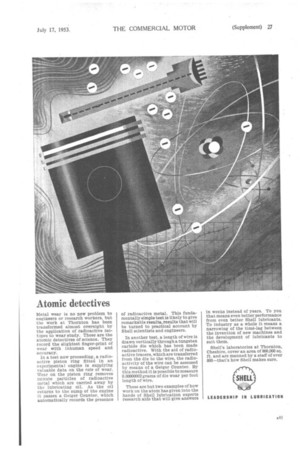Atomic detectives
Page 59

If you've noticed an error in this article please click here to report it so we can fix it.
Metal wear is no new problem to engineers or research workers, but the work at Thornton has been transformed almost overnight by the application of radioactive isotopes to wear study. These are the atomic detectives of science. They record the slightest finger-print of wear with inhuman speed and accuracy.
In a test now proceeding, a radioactive piston ring fitted in an experimental engine is supplying valuable data on the rate of wear. Wear on the piston ring removes minute particles of radioactive metal which are carried away by the lubricating oil. As the oil returns to the sump of the engine it passes a Geiger Counter, which automatically records the presence
of radioactive metal. This fundamentally simple test is likely to give remarkable results, results that will be turned to practical account by Shell scientists and engineers.
In another test, a length of wire is drawn vertically through a tungsten carbide die which has been made radioactive. With the aid of radioactive tracers, which are transferred from the die to the wire, the radioactivity of the wire can be assessed by means of a Geiger Counter. By this method it is possible to measure 0.00000002 grams of die wear per foot length of wire.
These are but two examples of how work on the atom has given into the hands of Shell lubrication experts research aids that will give answers in weeks instead of years. To you that means even better performance from even better Shell lubricants. To industry as a whole it means a narrowing of the time-lag between the invention of new machines and the development of lubricants to suit them.
Shell's laboratories at Thornton, Cheshire, cover an area of 800,000 sq. ft. and are manned by a staff of over 800—that's how Shell makes sure.




















































































